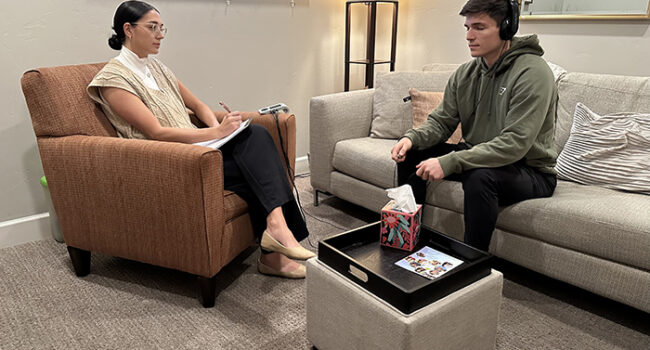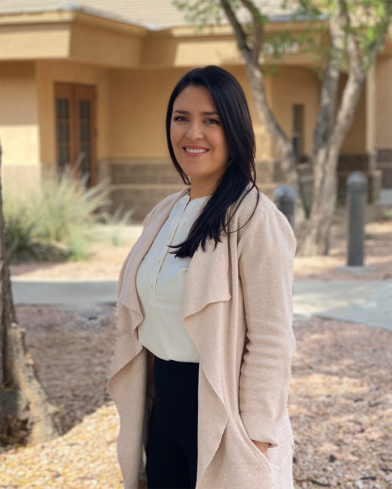
EMDR Therapy in Scottsdale, AZ
EMDR Therapy in Scottsdale, AZ
Finding Resolution for Trauma with Eye Movement Desensitization and Reprocessing
Do you ever feel stuck in the past no matter how hard you try to move forward? Many people struggle with lingering emotional pain, and as a result, their daily lives become overwhelming.
At Pathways Counseling Services in Scottsdale, we offer EMDR therapy, a research-backed and evidence-based approach designed to help clients heal from trauma, PTSD, anxiety, and emotional distress. Because EMDR targets the brain’s natural healing process, many individuals experience relief more quickly than with traditional talk therapy.

How Does EMDR Therapy Work?
What Is Audio Bilateral Stimulation?
To begin, audio bilateral stimulation is a core component of EMDR therapy. It involves sound alternating between the left and right ears in a rhythmic pattern. As a result, this back-and-forth movement mimics natural brain processes similar to REM sleep and helps activate both hemispheres of the brain.
While focusing on a specific memory, thought, or emotion, the alternating tones support the brain’s ability to reprocess distressing experiences. Consequently, clients often experience reduced emotional intensity and a greater sense of resolution. Additionally, this method is especially helpful for clients who prefer not to use visual cues, and it can be incorporated with headphones during sessions or in self-guided exercises between appointments.
How EMDR Therapy Works
In contrast to traditional talk therapy, EMDR therapy restructures the brain’s response to trauma by using bilateral stimulation as clients recall distressing memories. Through this process, the memory gradually shifts from an emotional, reactive state into a more regulated and manageable form.
During a typical EMDR session, a licensed therapist guides you through eye movements, tapping, or auditory tones. Meanwhile, they help you replace negative beliefs with healthier and more adaptive thoughts.
Benefits of EMDR Therapy
First, it reduces emotional distress linked to traumatic memories
Next, it uses sensory stimulation such as eye movement, sound, or tapping
Additionally, it does not require talking about the trauma in detail
Finally, it is often effective in fewer sessions than traditional therapy
Bilateral Stimulation BLS a core treatment for EMDR
Why Bilateral Stimulation Is Essential
Because bilateral stimulation (BLS) activates both sides of the brain, it plays a crucial role in EMDR therapy. This rhythmic left-to-right pattern helps the brain reprocess unresolved trauma more efficiently.
As a result, clients frequently experience:
Reduced anxiety
Clearer thinking
Less emotional reactivity
Noticeable relief, sometimes after only a few sessions
Ultimately, by engaging the body and brain together, bilateral stimulation supports deeper healing without requiring clients to retell painful memories repeatedly.

Phase 1: History Taking
The therapist gathers your history and identifies specific targets (memories, experiences) that will be addressed using EMDR therapy.
Phase 2: Preparation
You’ll learn grounding techniques, coping skills, and what to expect during EMDR sessions so you feel safe and prepared.
Phase 3: Assessment
Specific memories are selected for processing. You’ll identify images, thoughts, and body sensations connected to the memory.
Phase 4: Desensitization
With bilateral stimulation, the therapist guides you through processing the memory and reducing its emotional intensity.
Phase 5: Installation
Positive beliefs and self-statements are introduced to replace the old, negative beliefs linked to the trauma.
Phase 6: Body Scan
You’re asked to observe your body to identify any residual tension or distress, ensuring the memory has been fully processed.
Phase 7: Closure
The therapist ensures you're feeling grounded and calm before ending the session. Techniques may be used to help close emotional loops.
Phase 8: Reevaluation
At the next session, you’ll revisit the previous targets to ensure lasting change and identify new targets if needed.
Is EMDR Therapy Right for You?
Is Your Trauma Still Affecting You?
Have you ever felt like your trauma is still living inside you, even after years have passed? If so, you’re not alone — and there is a structured process that can help. Because EMDR therapy uses a phase-based approach, it guides the brain through healing in a safe, predictable, and effective way.
As therapy progresses, clients often report:
Renewed emotional stability
Increased clarity
Better coping skills
A stronger sense of control over their lives
Contact us for your EMDR session!
EMDR Therapy FAQs
What is EMDR therapy?
EMDR (Eye Movement Desensitization and Reprocessing) is a structured therapy that helps you reprocess distressing memories using bilateral stimulation like eye movements, sounds, or taps.
Is EMDR therapy safe?
Yes. EMDR is evidence-based and supported by organizations like the World Health Organization and the U.S. Department of Veterans Affairs. It is safe and effective when administered by a trained therapist.
Do I have to talk about my trauma in detail?
No. EMDR does not require you to talk through the details of your trauma. The focus is on how you feel now, and how your brain processes those experiences.
How many EMDR sessions do I need?
Many clients feel relief in just a few sessions. The number of sessions varies based on the complexity of your trauma and your goals for therapy.
Can EMDR help with anxiety or depression?
Absolutely. EMDR is not just for PTSD — it’s been proven effective for anxiety, panic attacks, depression, and low self-esteem linked to unresolved trauma.
Can EMDR therapy be done online or via telehealth?
Yes. Many therapists now offer EMDR sessions online using video conferencing and tools that simulate bilateral stimulation. Virtual EMDR has proven effective and convenient for clients who prefer therapy from home.
Is EMDR therapy emotionally intense?
EMDR can bring up strong emotions during processing, but the goal is healing—not re-traumatization. Your therapist will guide you at your pace, using grounding tools to keep the process safe and manageable.
Is EMDR therapy only for people with PTSD?
No. While EMDR is well-known for treating PTSD, it is also highly effective for anxiety, phobias, panic attacks, performance issues, grief, and even chronic pain rooted in unresolved emotional trauma.
EMDR- How It Can Help You Get Your Life Back
Meet Stephanie Levitt, MA, LPC, NCC Founder of Pathways Counseling Services
Stephanie Levitt, MA, LPC, NCC is a licensed professional counselor in Scottsdale, Arizona, with over 20 years of experience supporting individuals through anxiety, trauma, PTSD, and fear-based challenges. She is trained in a variety of evidence-based approaches, including exposure therapy, DBT and EMDR.
Stephanie believes in walking beside her clients with empathy, clarity, and clinical skill-offering a personalized approach to every individual. Her mission is to help you regain your confidence, reduce avoidance, and feel empowered again.
Outside the therapy room, Stephanie has been featured on. podcasts, radio shows, and panel discussions, where she speaks about trauma recover,, woman’s mental health, and practical therapy techniques.
View Stephanie’s profile on Psychology Today →
Contact us today for your EMDR session.
Phase 1: History Taking
During this initial phase, the therapist gathers your history and identifies specific memories or experiences to target throughout EMDR therapy.
Phase 2: Preparation
Next, you learn grounding techniques, coping skills, and what to expect during the EMDR process so you feel supported and prepared.
Phase 3: Assessment
Then, you identify images, thoughts, emotions, and body sensations connected to the memory that will be reprocessed.
Phase 4: Desensitization
During this phase, the therapist uses bilateral stimulation to guide you through processing the memory and reducing its emotional intensity.
Phase 5: Installation
Afterward, positive beliefs and adaptive thoughts are strengthened to replace negative beliefs linked to the traumatic memory.
Phase 6: Body Scan
At this stage, you scan your body for any lingering tension or discomfort to ensure the memory has been fully processed.
Phase 7: Closure
Before ending the session, your therapist helps you feel grounded and calm, ensuring emotional safety and stability.
Phase 8: Reevaluation
Finally, at the start of the next session, progress is reviewed to confirm lasting change and to identify new targets if needed.
Our Therapists
Meet Sofia Softas-Nall therapist Scottsdale AZ - Trauma, LGBTQIA Therapist
Read MoreSofia Softas-Nall, MS, MA, LPC, NCC
Therapist
Meet David Merrick, MS Ed. LPC-S - Teens and Adult Therapist
Read MoreDavid Merrick, MS Ed. LPC-S
Clinical Director
Meet Allison Zimmer, MS, LAC - Anxiety and Substance Therapist
Read MoreAllison Zimmer, MS, LAC
Therapist
Meet Haley Anderson, MSW, LMSW - Child and Teen Therapist
Read MoreHaley Anderson, MSW, LMSW
Therapist
Meet Stephanie Levitt, MA, LPC, NCC - EMDR Therapist
Read MoreStephanie Levitt, MA, LPC, NCC
Therapist
Your Path to Mental Wellness Begins Here
Give EMDR a try
Contact us today!
Want to know more, check out our blog.
No posts were found for provided query parameters.













